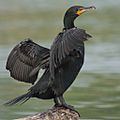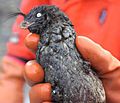Seabird facts for kids

Seabirds are amazing birds that have special features to help them live in or near the sea. Many seabirds spend most of their lives far out in the ocean. They only come back to land when it's time to have their babies. Other seabirds live in huge groups called colonies on islands. Seabirds often find their food in the sea, like fish or shellfish. The very first seabirds appeared a long, long time ago, when dinosaurs were still around! Modern seabird families started to show up later. Even though they are different types of birds, many seabirds look similar because they have all adapted to the same ocean life.
Seabirds share many cool adaptations that help them survive at sea. They often live longer than other birds. They also start having young later in life and have fewer babies at a time. But they spend a lot of time taking care of their young. Most seabirds build their nests in large colonies. These colonies can be small, with just a few dozen birds, or huge, with millions! Many species travel very long distances every year. Some even fly across the equator or all the way around the Earth! They find food both on the ocean's surface and deep underwater. Some even eat other seabirds. How much time a seabird spends at sea depends on its species.
Contents
How Seabirds Are Special
Seabirds have developed unique ways to live in the ocean. These special features help them find food, stay warm, and survive in salty water.
Eating in the Ocean
Seabirds have many different ways to catch their food. Some, like albatrosses, glide over the water and pick up food from the surface. Others, like gannets, dive headfirst into the water at high speeds to catch fish. Penguins and cormorants are excellent swimmers and divers. They use their strong wings or feet to chase fish underwater. Some seabirds, like frigatebirds, even steal food from other birds!
Staying Warm and Dry
Living in the ocean can be cold and wet. Seabirds have very dense, waterproof feathers that keep them warm and dry. They spread oil from a special gland near their tail onto their feathers. This oil makes their feathers repel water, just like a raincoat! Many seabirds also have a layer of fat under their skin to help them stay warm in chilly waters.
Drinking Saltwater
The ocean is full of salt, and most animals can't drink saltwater. But seabirds can! They have special glands above their eyes called "salt glands." These glands remove extra salt from their blood. The salt then drips out of their nostrils, often looking like a salty tear. This allows them to drink ocean water without getting sick.
Reproduction and Life Cycle
Seabirds have a unique way of raising their young. They often choose safe, remote places to breed.
Nesting in Colonies
Most seabirds nest together in large groups called colonies. These colonies can be found on remote islands, cliffs, or even floating ice. Nesting in a colony offers protection from predators. There are so many birds that it's harder for a predator to pick out just one. It also helps them find mates and share information about good feeding spots.
Raising Their Young
Seabirds usually lay only one or a few eggs. They spend a long time taking care of their chicks. Both parents often share the job of incubating the eggs and feeding the young. Because food can be hard to find in the ocean, it takes a lot of effort to raise a chick until it's ready to fly and find its own food. This long parenting period helps their few chicks survive and grow strong.
Amazing Migrations
Many seabirds are incredible travelers. They fly thousands of miles every year.
Why They Migrate
Seabirds migrate to find the best places for food and breeding. For example, some seabirds breed in the cold Arctic or Antarctic during the summer. When winter comes and food becomes scarce, they fly to warmer waters closer to the equator. This allows them to always be in a place where food is plentiful.
Long-Distance Journeys
Some seabirds, like the Arctic tern, are famous for their epic migrations. The Arctic tern flies from the Arctic to the Antarctic and back every year. This is the longest migration of any bird! These long journeys require incredible endurance and navigation skills. They use the sun, stars, and Earth's magnetic field to find their way.
Different Kinds of Seabirds
There are many different types of seabirds, each with its own special features.
- Albatrosses and Petrels: These birds are known for their long, narrow wings that help them glide effortlessly over the ocean for huge distances.
- Penguins: These flightless birds are amazing swimmers and divers. They live mostly in the Southern Hemisphere.
- Gulls and Terns: These are common seabirds often seen near coasts. Gulls are scavengers, while terns are graceful flyers that dive for fish.
- Puffins and Auks: These birds are like the "parrots of the sea" with their colorful beaks. They are excellent divers and often nest on cliffs.
Protecting Seabirds
Seabirds face many challenges today. Pollution, especially plastic in the ocean, can harm them. Overfishing can reduce their food supply. Climate change also affects their habitats and food sources. It's important to protect our oceans to ensure these amazing birds can continue to thrive for future generations.
Images for kids
-
Cormorants, like this double-crested cormorant, have plumage that is partly wettable. This functional adaptation balances the competing requirement for thermoregulation against that of the need to reduce buoyancy.
-
Wilson's storm petrels pattering on the water's surface
-
An African penguin skeleton, showing the sternal keel that makes the species a strong diver and swimmer
-
Common murres breed on densely packed colonies on offshore rocks, islands and cliffs.
-
This crested auklet was oiled in Alaska during the spill of MV Selendang Ayu in 2004.
-
Depiction of a pelican with chicks on a stained glass window, Saint Mark's Church, Gillingham, Kent
See also
 In Spanish: Ave marina para niños
In Spanish: Ave marina para niños








